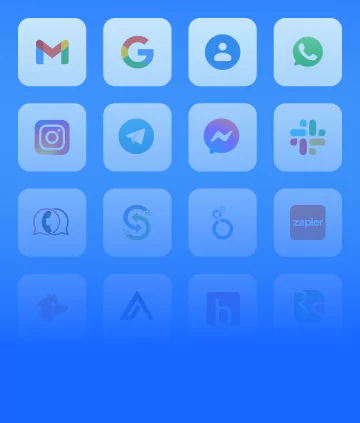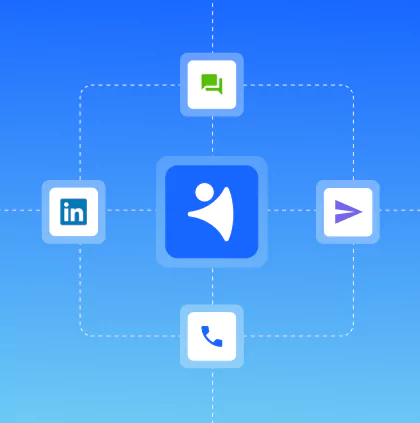Check out our step-by-step guide to asking the right discovery meeting questions.
We all know those top performers who win deals left and right. Is it their charm? Pure luck? Not quite. The real key often lies in how well they uncover prospect’s needs. And that all starts with a solid discovery meeting where you qualify the lead and find out their real needs to build a proper closing strategy.
But here’s the catch: a discovery meeting isn’t just about asking random questions as you’ll also need proper preparation and a good post-meeting follow-up.
So, how to make sure your discovery session is a success? Let’s find out.
What is a discovery meeting?
A discovery meeting, also called a discovery session, is an introductory meeting that a company has with a potential client to discuss their needs and challenges and decide whether the company’s solution and the prospect’s problem are a good fit for each other.
These meetings help you focus on the hottest leads and remove dead-end opportunities from your pipeline.
Here are the insights that teams commonly gain during discovery meetings:
- Structure of client business operations
- Customer short-term and long-term goals
- Core painpoints
- Project timeline
- Budget
How to prepare for a successful discovery meeting
What is a discovery session without structure? Just another aimless conversation that leads nowhere. To make the most of it, you’ll need a well-thought discovery meeting agenda. Here is what you’ll have to do for that.
Invite the right people
Ensure that key team members from your company join the meeting — especially those with tech- and product-specific expertise. Likewise, make sure key decision-makers from your prospect’s side join the session. And yes, sometimes, it’s easier said than done because these stakeholders are often busy and may hesitate to commit to a discovery call.
Here is what you can do to increase the show rates:
- Share a short discovery session agenda in advance with them (if that is possible). Let them know the call will be structured, concise, and focused on the discussion of the company’s pain points and potential solutions.
- Offer scheduling flexibility. Suggest multiple time slots and be accommodating to their schedules.
- Engage their close collaborators if direct decision-makers aren’t available.
- Use social proof. Mention similar companies or decision-makers in their industry who found value in your product.
Research your prospect

Dmytro Katiukha
VP Sales, NetHunt CRM"Context is the key to a great discovery call. Do your homework, check who you talk to, what’s their titles and duties, what brought them to a call with you, etc."
Save some time and do your homework before the call.
Find out their:
- Industry challenges and trends. Check industry reports (sources like Forrester and McKinsey might be helpful here), news articles, and LinkedIn discussions to stay updated.
- Business values and mission. Visit their website’s "About Us" page and social media profiles. Pay attention to their LinkedIn company page and any recent press releases.
- Competitors. Look at who they’re up against by searching on Google, industry directories, LinkedIn, and databases like Crunchbase.
- Solutions they’ve already tried (if that is possible). Check their LinkedIn posts or company blog for hints about past strategies, or even ask them directly before creating an agenda so you can research the solutions they’ve tried later (what if one of the solutions is YOUR competitor? ?)
Identify potential doubts
What concerns might the prospect have? As a true sales rep, be ready with answers and solutions to address objections before they even arise. However, remember that a discovery session is about understanding the prospect’s needs and wants, not closing the deal or being too pushy.

Dmytro Katiukha
VP Sales, NetHunt CRM"If I had to name one mistake that often costs a sales rep the deal, I would definitely go for sales reps aiming to close a deal right there on a discovery call. That almost always backfires and is like trying to win the game before it's even started."
? We stay organized by keeping all data related to sales discovery sessions in one place. You can store discovery meeting templates, the notes you've made during pre-meeting research, and easily add meeting insights during the conversation.
Set and share a discovery meeting agenda
A structured agenda demonstrates respect for your prospect’s time and keeps the meeting productive. You can:
? Send a web form with key questions before the call to gather essential data
? Draft a personalized email, attach the agenda, and ask for the confirmation of the meeting timeline (perhaps, your client will offer a few suggestions here and there)
⏳ Pro Tip: Before scheduling, ensure all key decision-makers are attending to avoid repeating conversations later, which can lengthen your sales cycle and reduce the effectiveness of your discovery call.
What to ask during the sales discovery session
A discovery meeting agenda template works magic but only if you know how to ask the right closing questions and truly listen. Don’t treat your entire meeting like a monologue — let your client speak by keeping your conversation back and forth. Here is how it usually goes.
#1: Build rapport and address the purpose of the call
People buy from people they like, so show genuine interest in your lead. A few ice-breakers like asking about their day, current projects, or even something lighthearted like a recent hobby or interest can help.
Then, move to the agenda and ask if they'd like to add anything to it, so you can make time for it in advance.
And don’t be afraid to be too ‘nosy.’ Top performers have 76% longer calls and ask 39% more questions during discovery sessions.

Dmytro Katiukha
VP Sales, NetHunt CRM"Prepare and announce the agenda, and, of course, make sure to handle the call time wisely so that you cover everything. After all, you only get one chance to make a first impression."
#2: Understand lead’s motivation and expectations
Here are the core things to discover as early as possible.
Goals
Know their goals so you can speak directly to what’s important to them.
- What are you hoping to achieve with the help of a solution you’re looking for? Growing revenue? Automating processes?
- What are your top priorities for this quarter/year?
- Which key metrics or KPIs are you responsible for improving?
- What’s one thing that would make your job way easier?
Challenges
Identifying their pain points allows you to position your solution effectively and avoid losing customers to competitors.
- What’s currently standing in your way?
- Are there any bottlenecks slowing you down — like outdated tech, manual processes, or too many tasks on your plate?
- If you could eliminate one major challenge today, what would it be?
Timeline
Ask about their timeline to understand whether you can manage their expectations.
- How soon are you looking to implement a solution?
- Is this a priority right now, or more of a long-term project?
- Are there any internal deadlines or external factors driving your timeline?
- What’s your process for evaluating and choosing a solution?
Scope
When you understand the scope early, you can tailor the pitch while preparing your discovery session agenda and get to the heart of what your prospect needs.
- Are you looking for a solution for a single department, or something that can support the entire company?
- Who else in your team would be involved in this decision?
- Would you need integration with any existing tools or workflows?
#3: Assess what works and what doesn’t and offer solutions
Your lead might not even know what their biggest challenges are yet and how to solve them. And that’s where you come in with the right discovery meeting agenda questions like:
- Which was the best and the worst solution for your problem? — This helps you understand what’s worked (or hasn’t) in the past, so you can offer a better, more effective solution.
- Who do you think your biggest competitor is, and why? — Understanding how they see their competition can give you insights into what they're striving for in the market.
- Why did you choose us? — Did they hear about you through a referral or did they love a specific feature? This question helps you reinforce those selling points.
- What would success look like for you in 6 months? — As you can see, the discovery session meaning is also about understanding the prospect’s vision of the future, not only their challenges in the present.
- What is the most frustrating part of your current process/system? — With this question, you can tap into the prospect’s pain points, making it easier to position your solution as the fix for their headaches.
The discovery session ending: To be continued…
You don’t just ask questions and leave. A discovery meeting meaning is also about setting the stage for what comes next!
- Map out the path. If they’re the right fit, let them know what the next stage looks like. Is it a product demo? A trial period? Make it clear and actionable.⏰ For instance, we use NetHunt CRM to track all our lead interactions in the Timeline section from the very beginning of a customer buying journey. And you can do the same! Once a lead becomes your client, you’ll easily be able to review past conversations before meetings and see who else from your team has interacted with the lead.
- Schedule a follow-up meeting right on the spot if possible and if that’s what your prospect wants.
- Know when to step back. If the prospect isn’t quite ready or seems uncertain, don’t push too hard. It’s okay to step away and give them time to think things over.
? With NetHunt CRM, sales reps can speed up their follow-ups after discovery sessions using pre-made email templates and task reminders. Instead of writing each message from scratch, they can quickly personalize a follow-up email or a gentle-nudge one if there’s no response.
? ? You can also create tasks in NetHunt CRM before and after your sales discovery call and assign them to the right team member.

Dmytro Katiukha
VP Sales, NetHunt CRM"A great follow-up is essential, but it won't fix a poor discovery call. The call itself needs to be strong. The sales job is done on a call, while a follow-up recaps what was discussed and outlines the next steps, which by turn, should have been agreed upon on a call itself."
Final thoughts
The best discovery sessions are conversations, not interrogations or monologues. Your goal is to build trust, uncover pain points, and set the stage for a solid next step (that good old follow-up, remember?).
With the right questions, a proper discovery meeting agenda template, and a little curiosity, you’ll make the process enjoyable and productive at the same time.
Good luck, and happy selling! ✨




















 product experts — let's find the best setup for your team
product experts — let's find the best setup for your team